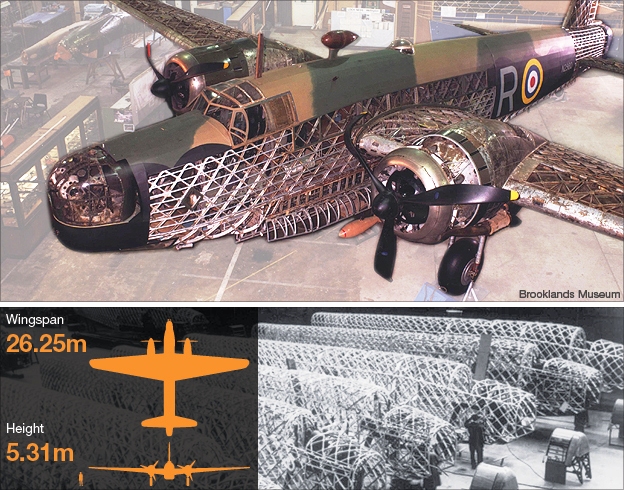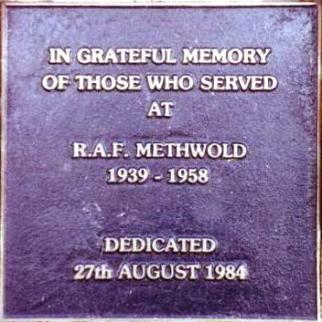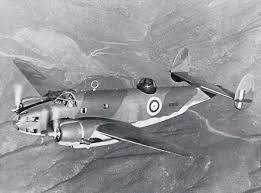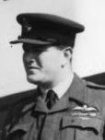31 Base RAF Methwold 1943-44
31 Base Methwold (Norfolk) 28th January to 3rd February 1944 – Substation
(Actual Log Dates State 11th December 1943 to 10th January 1944) (4 weeks)
Training on 2-Engined Wellington 1C, Familiarisation, Night Flying & High-Level Bombing
Assessment of Ability – Above Average – 13th January 1944
 The Wellington began life as a response to the B.9/32 Bomber specification of 1932. This called for a Twin-Engine Day Bomber capable of carrying a 1000lb bomb load and with a range of 720 miles. If the Wellington had been designed to this Specification, we would probably never have heard of it. The design of what would become the Wellington evolved rapidly over the next few years, with both Vickers and then the Air Ministry increasing its Performance, until when the 1st Prototype flew it was capable of carrying 4,500 lbs of Bombs and a maximum Range of 2,800 miles, while the empty weight had almost doubled, from the 6,300lbs of the original specification to 11,508 lbs for the 1st Prototype. The Wellington was the Brainchild of Barnes Wallis, most famous for the Bouncing Bomb of Dam Buster’s Fame. After a long period spent working for Vickers on Airships, Wallis had moved to the Design of Aircraft. His main early contribution to the field was the invention of the geodetic method of Aircraft Production. In this system, the Aircraft Fuselage was made of a lightweight Grid of relatively simple parts that combined to produce strong, light, flexible Aircraft. The “basket weave” Structure of the Aircraft would then be covered with a layer of cloth proofed with highly inflammable ‘Dope’.
The Wellington began life as a response to the B.9/32 Bomber specification of 1932. This called for a Twin-Engine Day Bomber capable of carrying a 1000lb bomb load and with a range of 720 miles. If the Wellington had been designed to this Specification, we would probably never have heard of it. The design of what would become the Wellington evolved rapidly over the next few years, with both Vickers and then the Air Ministry increasing its Performance, until when the 1st Prototype flew it was capable of carrying 4,500 lbs of Bombs and a maximum Range of 2,800 miles, while the empty weight had almost doubled, from the 6,300lbs of the original specification to 11,508 lbs for the 1st Prototype. The Wellington was the Brainchild of Barnes Wallis, most famous for the Bouncing Bomb of Dam Buster’s Fame. After a long period spent working for Vickers on Airships, Wallis had moved to the Design of Aircraft. His main early contribution to the field was the invention of the geodetic method of Aircraft Production. In this system, the Aircraft Fuselage was made of a lightweight Grid of relatively simple parts that combined to produce strong, light, flexible Aircraft. The “basket weave” Structure of the Aircraft would then be covered with a layer of cloth proofed with highly inflammable ‘Dope’.
One of our Aircraft is Missing
“The expansion of Bomber Command in 1942/43 began to put a severe strain on the organisational administration of its Units resulting in the introduction of an intermediate level of command between Group HQ’s & Station. Thus in March 1943 was born the Base System. A Base consisted of a Base Station with 1 or 2 Sub-stations. Each Base was Commanded by an Air Commodore and initially identified by the name of the Base Station and the role of the Base, e.g. Topcliffe Training Base, Leeming Operational Base. However, from September 1943, Bases were re-designated by a 2-number identifier, the 1st number indicating the Group and the 2nd the number of the Base within that Group, the 1st in each Group being the Group’s Training Base.
No 31 Base
Stradishall (25th May 1943), Ridgewell (May 1943 only), Chedburgh (June 1943), Wratting Common, Gosfield (C & M), Matching (C & M), Shepherd’s Grove (C & M), Tempsford, Feltwell. Formed 25th May 1943 when HQ transferred from Newmarket/Mildenhall.


 RAF Methwold was opened in September 1939 initially as a Dispersal landing ground for RAF Feltwell. The Airfield was for a number of years under the Control of No.2 Group being used by its Lockheed Ventura Squadrons. The final Bomber Operation for the Ventura was flown in September 1943, by which time Ventura Squadrons had transferred to the 2nd Tactical Air Force.
RAF Methwold was opened in September 1939 initially as a Dispersal landing ground for RAF Feltwell. The Airfield was for a number of years under the Control of No.2 Group being used by its Lockheed Ventura Squadrons. The final Bomber Operation for the Ventura was flown in September 1943, by which time Ventura Squadrons had transferred to the 2nd Tactical Air Force.
The Ventura, (The Pig) a derivative of the popular Hudson then in Service with Coastal Command on Anti-Shipping & Reconnaissance tasks, replaced Blenheim Day-Bombers in No.2 Group. By the time it entered service with Bomber Command, was outdated and suffered heavy losses.
Three Runways were laid and T2 Hangers erected bringing the Airfield to a Class A Station. In August 1943 it becomes No.31 Base Substation. In August 1943 the Airfield was closed to flying while it was upgraded to A Standard. Three concrete Runways were built, the main aligned on 06-24 (2,000 yards), 11-29 (1,600 yards) & 17-35 (1,500 yards). 36 Hard-standings were built, 35 of the Loop type and a Single Pan. The original Asphalt Pans were not retained. Following this work, RAF Methwold was a higher standard base than its parent at RAF Feltwell. The Airfield was returned to No. 3 Group and became a Sub-station of RAF Mildenhall.
43 Aircraft either failed to Return or Crashed during the Operations from RAF Methwold; 25 Venturas, 6 Stirlings, & 12 Lancasters.
Basic Crew Training was undertaken at Operational Training Units (OTU), controlled by the 3 Training Groups and did not come under this system. However, having completed Crew Training, usually on Wellingtons, Conversion to the 4 Engined ‘Heavies’ was conducted at a Heavy Conversion Unit (HCU). These HCU‘s were located at the Group’s Training Base until November 1944, when all HCU‘s were transferred to No 7 (Training) Group. On transfer the Base identifier changed, with the 1st number a 7, still indicating the Group but the 2nd number now indicated the Base’s original Group, e.g. 71 came from No.1 Group & 75 came from No.5 Group. Besides the 3 Training Groups (No’s 91, 92 & 93), No’s 8 & 100 Groups did not use this system.
The HCU Training Schedule, included the following training exercises: Heavy Conversion Unit (course syllabus)
- Familiarisation
- Circuits and landings
- Bombing
- Fighter affiliation
- Cross-country
Ground School Lessons – Mornings
1. Pre-flight checks. Starting the Halifax
2. Running Up the Halifax
3. Breaking the Halifax
4. Aircraft, Airfield & Local Area
5. Day & Night Landings
6. Overshoots
7. 3-Engine Flying generally
8. Feathering Propellers Procedure
9. 3-Engine Landings – instructors demonstration and pupil pilot.
10. 3-Engine Overshoots
11. Fire Drill – action in the event of Fire
12. Cross-Wind Landings
13. Ditching & Emergency procedures
14. Automatic Pilot ‘George‘. Fighter Affiliation
15. Familiarisation with the new Halifax III
“Crewing Up”
The Heavy Bombers needed a Crew of 7; Pilot, Flight Engineer, Navigator, Wireless Operator, Bomb Aimer, Mid-upper Gunner & Rear Gunner. Each member of the Aircrew had been taught their ‘Trade’ at Specialist Schools, either in the UK or Overseas. Having completed their Basic Training, 5 of the Trades, (Pilot, Nav, W/Op, Bomb Aimer & one of the AG’s) “Crewed up” at an Operational Training Unit (OTU) and trained as a 5 man Crew on 2-engined Medium Bombers. Once they were Competent, the 5 man Crew would Transfer to a Heavy Conversion Unit, where they would be joined by a Flight Engineer and an additional Air Gunner (for the Mid-Upper Turret position) to form a 7 man Crew for the 4-Engined Heavy Bombers.
Choosing Crews were generally left to the Airmen themselves. They were put in a Room, or in a Hanger with a cup of tea and or a cigarette, and the Pilots would chat to say 30 of each Trade, and decide who he thought was a likely Prospect, and by the time you came out of the Room you had joined a Crew. It was very transitory, you just sort of gelled and that was it.
Air School – Flying lessons.
1. Aircraft pre-flight checks, Airfield, relief Airfield, local Area, Approach & Departure Familiarisation. 8 crew. (Checks in conjunction with the Pilot & Ground Crew)
- that there was no visible damage, in particular to the working parts and leading edges of the Airframe
- that the Tyres were in good order
- that there were no Coolant or Oil leaks
- that the Oxygen supply was functioning
- that the internal Latches were all secure
- that Fire Extinguishers, Axes etc were properly stowed
2. Dual – General Air Experience Flying – Flying Instructor, Pilot, Navigator, Wireless Operator. 4 crew
3. Dual – Circuits & Landings, Overshoot procedure, 4 Crew
4. Dual – 3-Engine Flying. 4 crew.
5. Solo – Circuits & Landings, 7 crew
6. Dual – Check Overshoot procedure, Forced Landings, 8 crew – usual 7 plus Instructor
7. Solo – no Instructor. Circuits & Landings, 3-engine flying, 7 crew
8. Solo – no Instructor. Circuits & Landings. 7 crew
9. Dual – 3-Engine Landings & Overshoots, 2-Engine Airborne Flying, 8 crew
10. Solo – no Instructor Bombing Practice, Wireless Operating, Map Reading, Radar Operating. 7 crew
11. Solo – no Instructor, Air to Air Gun Firing practice, Aerial Combat Day & Night, evasive flying, corkscrew flying. Evacuating/Baling out. 7 crew.
12. Dual – Fighter Affiliation exercises with Spitfire, Hurricane, Beaufighter & Mosquito Aircraft. 8 crew.
13. Solo – no Instructor Fighter Affiliation, 3-Engine Flying. 7 crew
14. Solo – no Instructor Bombing Practice. 7 crew
15. Dual – Night Circuits & Landings – completed in 2 nights with check dual 2nd night prior to Solo, 8 crew.
16. Solo – no Instructor Night Circuits & Landings, 7 crew
17. Solo – Day Cross-country, 7 crew
18. Solo – no Instructor, Night bombing, 7 crew
19. Solo – no Instructor, Night cross-country, 7 crew
20. Solo – no Instructor, Operational exercise, 7 crew

Hello,
I am searching for information on Leading Air Craftsman that would have been posted at Methwold in, or around October/November 1943. Any help on how I can obtain this information would be greatly appreciated.
Thank you, – Joanne Stackhouse
LikeLike
Methwold was an RAF Training Base and without further details as to which squadron Squadron he was attached to – it is hard to direct you. The following Squadrons were associated with No.31 Base RAF Methwold. You could approach any surviving Squadron Association. Was he Ground crew or Aircrew?
Methwold Squadrons
No. 37 Squadron RAF
No. 214 Squadron RAF
No. 21 Squadron RAF
No. 464 Squadron RAAF
No. 487 Squadron RNZAF
No. 149 Squadron RAF
No. 218 Squadron RAF
No. 207 Squadron RAF
LikeLike
Thank you! I actually found my mothers biological father through Ancestry UK!
LikeLike